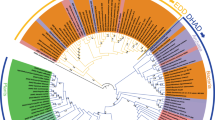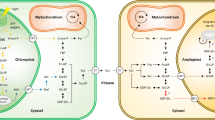Abstract
Progress in DNA sequencing of plant genomes has revealed that, in addition to microorganisms, a number of plants contain genes which share similarity to microbial 1-aminocyclopropane-1-carboxylate (ACC) deaminases. These enzymes cleave ACC, the immediate precursor of ethylene in plants, into ammonia and α-ketobutyrate. We therefore sought to isolate putative ACC deaminase cDNAs from tomato plants with the objective of establishing whether the product of this gene is a functional ACC deaminase. In the work reported here, it was demonstrated that the enzyme encoded by the putative ACC deaminase cDNA does not have the ability to break the cyclopropane ring of ACC, but rather it utilizes d-cysteine as a substrate, and in fact encodes a d-cysteine desulfhydrase. Kinetic characterization of the tomato enzyme indicates that it is similar to other, previously characterized, d-cysteine desulfhydrases. Using site-directed mutagenesis, it was shown that altering only two amino acid residues within the predicted active site served to change the enzyme from d-cysteine desulfhydrase to ACC deaminase. Conversely, by altering two amino acid residues at the same positions within the active site of ACC deaminase from Pseudomonas putida UW4 the enzyme was converted into d-cysteine desulfhydrase. Therefore, it is possible that a change in these two residues may have occurred in an ancestral protein to result in two different enzymatic activities.





Similar content being viewed by others
Abbreviations
- ACC:
-
1-Aminocyclopropane-1-carboxylate
- PLP:
-
Pyridoxal phosphate
- TRPSβ:
-
Tryptophan synthase β-subunit
References
Adams DO, Yang SF (1979) Ethylene biosynthesis: identification of 1-aminocyclopropane-1-carboxylic acid as an intermediate in the conversion of methionine to ethylene. Proc Natl Acad Sci USA 76:170–174
Bleecker AB, Kende H (2000) Ethylene: a gaseous signal molecule in plants. Annu Rev Cell Dev Biol 16:1–18
Bloem E, Riemenschneider A, Volker J, Papenbrock J, Schmidt A, Salac I, Haneklaus S, Schnug E (2004) Sulphur supply and infection with Pyrenopeziza brassicae influence l-cysteine desulphydrase activity in Brassica napus L. J Exp Bot 55:2305–2312
Blume B, Grierson D (1997) Expression of ACC oxidase promoter-GUS fusions in tomato and Nicotiana plumbaginifolia regulated by developmental and environmental stimuli. Plant J 12:731–746
Breitinger U, Clausen T, Ehlert S, Huber R, Laber B, Schmidt F, Pohl E, Messerschmidt A (2001) The three-dimensional structure of cystathionine beta-lyase from Arabidopsis and its substrate specificity. Plant Physiol 126:631–642
Cheng Y, Prusoff WH (1973) Relationship between the inhibition constant (K1) and the concentration of inhibitor which causes 50 per cent inhibition (I50) of an enzymatic reaction. Biochem Pharmacol 22:3099–3108
Davis LG, Dibner MD, Battey JF (1986) Guanidine isothiocyanate preparation of RNA. In: Davis LG, Dibner MD, Battey JF (eds) Basic methods in molecular biology. Elsevier, New York, pp 130–135
Dawson RMC, Elliott DC, Elliott WH, Jones KM (1987) Vitamins and coenzymes. In: Dawson RMC, Elliott DC, Elliott WH, Jones KM (eds) Data for biochemical research, 3rd edn. Oxford University Press, New York, p 122
Edgar RC (2004) MUSCLE: multiple sequence alignment with high accuracy and high throughput. Nucleic Acids Res 32:1792–1797
Farwell AJ, Vesely S, Nero V, Rodriguez H, McCormack K, Shah S, Dixon DG, Glick BR (2007) Tolerance of transgenic canola plants (Brassica napus) amended with plant growth-promoting bacteria to flooding stress at a metal-contaminated field site. Environ Pollut 147:540–545
Fujino A, Ose T, Yao M, Tokiwano T, Honma M, Watanabe N, Tanaka I (2004) Structural and enzymatic properties of 1-aminocyclopropane-1-carboxylate deaminase homologue from Pyrococcus horikoshii. J Mol Biol 341:999–1013
Gallagher DT, Gilliland GL, Xiao G, Zondlo J, Fisher KE, Chinchilla D, Eisenstein E (1998) Structure and control of pyridoxal phosphate dependent allosteric threonine deaminase. Structure 6:465–475
Geourjon C, Deleage G (1994) SOPM: a self-optimized method for protein secondary structure prediction. Protein Eng 7:157–164
Gouet P, Robert X, Courcelle E (2003) ESPript/ENDscript: extracting and rendering sequence and 3D information from atomic structures of proteins. Nucleic Acids Res 31:3320–3323
Grichko VP, Glick BR (2001) Flooding tolerance of transgenic tomato plants expressing the bacterial ACC deaminase controlled by the 35S, rolD or PRB-1b promoter. Plant Physiol Biochem 39:19–25
Grichko VP, Filby B, Glick BR (2000) Increased ability of transgenic plants expressing the bacterial enzyme ACC deaminase to accumulate Cd, Co, Cu, Ni, Pb, and Zn. J Biotechnol 81:45–53
Hall TA (1999) BioEdit: a user-friendly biological sequence alignment editor and analyses program for Windows 95/98/NT. Nucleic Acids Symp Ser 41:95–98
Hamilton AJ, Lycette GW, Grierson D (1990) Antisense gene that inhibits synthesis of the hormone ethylene in transgenic plants. Nature 346:284–287
Hofmann K, Bucher P, Falquet L, Bairoch A (1999) The PROSITE database, its status in 1999. Nucleic Acids Res 27:215–219
Honma M (1985) Chemically reactive sulfhydryl groups of 1-aminocyclopropane-1-carboxylate deaminase. Agric Biol Chem 49:567–571
Honma M, Shimomura T (1978) Metabolism of 1-aminocyclopropane-1-carboxylic acid. Agric Biol Chem 42:1825–1831
Honma M, Kawai J, Yamada M (1993) Identification of the reactive sulfhydryl group of 1-aminocyclopropane-1-carboxylate deaminase. Biosci Biotechnol Biochem 57:2090–2093
Hontzeas N, Zoidakis J, Glick BR, Abu-Omar MM (2004) Expression and characterization of 1-aminocyclopropane-1-carboxylate deaminase from the rhizobacterium Pseudomonas putida UW4: a key enzyme in bacterial plant growth promotion. Biochim Biophys Acta 1703:11–19
Hua J, Sakai H, Nourizadeh S, Chen QG, Bleecker AB, Ecker JR, Meyerowitz EM (1998) EIN4 and ERS2 are members of the putative ethylene receptor gene family in Arabidopsis. Plant Cell 10:1321–1332
Jacobson CB, Pasternak JJ, Glick BR (1994) Partial purification and characterization of 1-aminocyclopropane-1-carboxylate deaminase from the plant growth promoting rhizobacterium Pseudomonas putida GR12–2. Can J Microbiol 40:1019–1025
Jia YJ, Kakuta Y, Sugawara M, Igarashi T, Oki N, Kisaki M, Shoji T, Kanetuna Y, Horita T, Matsui H, Honma M (1999) Synthesis and degradation of 1-aminocyclopropane-1-carboxylic acid by Penicillium citrinum. Biosci Biotechnol Biochem 63:542–549
John RA (1995) Pyridoxal phosphate-dependent enzymes. Biochim Biophys Acta 1248:81–96
Kabsch W, Sander C (1983) Dictionary of protein secondary structure: pattern recognition of hydrogen-bonded and geometrical features. Biopolymers 22:2577–2637
Karthikeyan S, Zhao Z, Kao CL, Zhou Q, Tao Z, Zhang H, Liu HW (2004a) Structural analysis of 1-aminocyclopropane-1-carboxylate deaminase: observation of an aminyl intermediate and identification of Tyr 294 as the active-site nucleophile. Angew Chem Int Ed Engl 43:3425–3429
Karthikeyan S, Zhou Q, Zhao Z, Kao CL, Tao Z, Robinson H, Liu HW, Zhang H (2004b) Structural analysis of Pseudomonas 1-aminocyclopropane-1-carboxylate deaminase complexes: insight into the mechanism of a unique pyridoxal-5′-phosphate dependent cyclopropane ring-opening reaction. Biochemistry 43:13328–13339
Klee HJ, Hayford MB, Kretzmer KA, Barry GF, Kishore GM (1991) Control of ethylene synthesis by expression of a bacterial enzyme in transgenic tomato plants. Plant Cell 3:1187–1193
Kuiper MJ, Davies PL, Walker VK (2001) A theoretical model of a plant antifreeze protein from Lolium perenne. Biophys J 81:3560–3565
Laskowski RA, MacArthur MW, Moss DS, Thornton JM (1993) PROCHECK: a program to check the stereochemical quality of protein structures. J Appl Crystallogr 26:283–291
Li J, Shah S, Moffatt BA, Glick BR (2001) Isolation and characterization of an unusual 1-aminocyclopropane-1-carboxylic acid (ACC) deaminase gene from Enterobacter cloacae UW4. Antonie Van Leeuwenhoek 80:255–261
Liu HW, Auchus R, Walsh C (1984) Stereochemical studies on the reactions catalyzed by the PLP-dependent enzyme 1-aminocyclopropane-1-carboxylate deaminase. J Am Chem Soc 106:5335–5348
Marabotti M, D’Auria S, Rossi M, Facchiano M (2004) Theoretical model of the three-dimensional structure of a sugar-binding protein from Pyrococcus horikoshii: structural analysis and sugar-binding simulations. Biochem J 380:677–684
Mayak S, Tirosh T, Glick BR (2004) Plant growth-promoting bacteria confer resistance in tomato plants to salt stress. Plant Physiol Biochem 42:565–572
McDonnell L, Plett JM, Andersson-Gunnerås S, Kozela C, Glick BR, Sundberg B, Regan S (2008) Ethylene levels are regulated by a plant encoded 1-aminocyclopropane-1-carboxylic acid deaminase. Physiol Plant (in press)
Minami R, Uchiyama K, Murakami T, Kawai J, Mikami K, Yamada T, Yokoi D, Ito H, Matsui H, Honma M (1998) Properties, sequence, and synthesis in Escherichia coli of 1-aminocyclopropane-1-carboxylate deaminase from Hansenula saturnus. J Biochem 123:1112–1118
Murzin AG, Brenner SE, Hubbard T, Clothia C (1995) SCOP: a structural classification of proteins database for the investigation of sequences and structures. J Mol Biol 247:536–540
Nagasawa T, Ishii T, Kumagai H, Yamada H (1985) d-Cysteine desulfhydrase of Escherichia coli. Purification and characterization. Eur J Biochem 153:541–551
Orengo CA, Michie AC, Jones S, Jones DT, Swindells MB, Thornton JM (1997) CATH—a hierarchic classification of protein domain structures. Structure 5:1093–1108
Ose T, Fujino A, Yao M, Watanabe N, Honma M, Tanaka I (2003) Reaction intermediate structures of 1-aminocyclopropane-1-carboxylate deaminase: insight into PLP-dependent cyclopropane ring-opening reaction. J Biol Chem 278:41069–41076
Papenbrock J, Riemenschneider A, Kamp A, Schulz-Vogt HN, Schmidt A (2007) Characterization of cysteine-degrading and H2S-releasing enzymes of higher plants—from the field to the test tube and back. Plant Biol (Stuttg) 9:582–588
Perkins DN, Pappin DJ, Creasy DM, Cottrell JS (1999) Probability-based protein identification by searching sequence databases using mass spectrometry data. Electrophoresis 20:3551–3567
Reed ML, Warner BG, Glick BR (2005) Plant growth-promoting bacteria facilitate the growth of the common reed Phragmites australisin the presence of copper or polycyclic aromatic hydrocarbons. Curr Microbiol 51:425–429
Riemenschneider A, Wegele R, Schmidt A, Papenbrock J (2005) Isolation and characterization of a d-cysteine desulfhydrase protein from Arabidopsis thaliana. FEBS J 272:1291–1304
Rost B (1996) PHD: predicting one-dimensional protein structure by profile-based neural networks. Methods Enzymol 266:525–539
Rottmann WH, Peter GF, Oeller PW, Keller JA, Shen NF, Nagy BP, Taylor LP, Campbell AD, Theologis A (1991) 1-aminocyclopropane-1-carboxylate synthase in tomato is encoded by a multigene family whose transcription is induced during fruit and floral senescence. J Mol Biol 222:937–961
Sambrook J, Russell DW (2001) Molecular cloning: a laboratory manual, 3rd edn. Cold Spring Harbor Laboratory Press, New York
Schmidt A (1982) A cysteine desulfhydrase from spinach leaves specific for d-cysteine. Z Pflanzenphysiol 107:295–300
Sergeeva E, Shah S, Glick BR (2006) Tolerance of transgenic canola expressing a bacterial ACC deaminase gene to high concentrations of salt. World J Microbiol Biotechnol 22:277–282
Soutourina J, Blanquet S, Plateau P (2001) Role of d-cysteine desulfhydrase in the adaptation of Escherichia coli to d-cysteine. J Biol Chem 276:40864–40872
Sterky F, Regan S, Karlsson J, Hertzberg M, Rohde A, Holmberg A, Amini B, Bhalerao R, Larsson M, Villarroel R, Van Montagu M, Sandberg G, Olsson O, Teeri TT, Boerjan W, Gustafsson P, Uhlén M, Sundberg B, Lundeberg J (1998) Gene discovery in the wood-forming tissues of poplar: analysis of 5, 692 expressed sequence tags. Proc Natl Acad Sci USA 95:13330–13335
Walsh C, Pascal RA Jr, Johnston M, Raines R, Dikshit D, Krantz A, Honma M (1981) Mechanistic studies on the pyridoxal phosphate enzyme 1-aminocyclopropane-1-carboxylate deaminase from Pseudomonas sp. Biochemistry 20:7509–7519
Yang SF, Hoffman NE (1984) Ethylene biosynthesis and its regulation in higher plants. Annu Rev Plant Physiol 35:155–189
Yao M, Ose T, Sugimoto H, Horiuchi A, Nakagawa A, Wakatsuki S, Yokoi D, Murakami T, Honma M, Tanaka I (2000) Crystal structure of 1-aminocyclopropane-1-carboxylate deaminase from Hansenula saturnus. J Biol Chem 275:34557–34565
Zarembinski TI, Theologis A (1994) Ethylene biosynthesis and action: a case of conservation. Plant Mol Biol 26:1579–1597
Zhao Z, Liu HW (2002) Synthesis of labeled 1-amino-2-methylenecyclopropane-1-carboxylic acid, an inactivator of 1-aminocyclopropane-1-carboxylate deaminase. J Org Chem 67:2509–2514
Zhao Z, Chen H, Li K, Du W, He S, Liu HW (2003) Reaction of 1-amino-2-methylenecyclopropane-1-carboxylate with 1-aminocyclopropane-1-carboxylate deaminase: analysis and mechanistic implications. Biochemistry 42:2089–2103
Acknowledgments
The work reported here was founded by a Discovery Grant from the Natural Science and Engineering Research Council of Canada to Bernard R. Glick. We thank Dr Ed Bayer, Weizmann Institute of Science, for critically reading the manuscript and Mr Zhenyu Cheng for help with mass spectrometry.
Author information
Authors and Affiliations
Corresponding author
Additional information
Accession numbers: The nucleotide sequence for tomato d-cysteine desulfhydrase has been deposited to GenBank Data Libraries with the accession number EU639448.
Rights and permissions
About this article
Cite this article
Todorovic, B., Glick, B.R. The interconversion of ACC deaminase and d-cysteine desulfhydrase by directed mutagenesis. Planta 229, 193–205 (2008). https://doi.org/10.1007/s00425-008-0820-3
Received:
Accepted:
Published:
Issue Date:
DOI: https://doi.org/10.1007/s00425-008-0820-3




